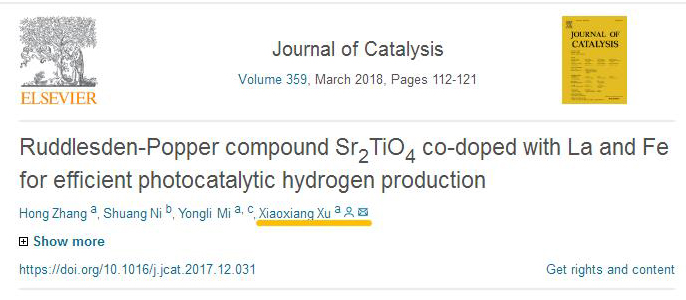Important progress in photocatalytic water splitting of layered perovskite materials
by Prof. Xiaoxiang Xu’s group
The shortage of fossil fuel reservoir on earth as well as environmental degradations associated with fuel cell consumptions are two major challenges for our modern society. It is now a global agreement to search/develop clean and sustainable energy resources/technologies so that we can ultimately be released from fossil fuel reliance. Splitting water molecules into H2 and O2 stoichiometrically on a particulate photocatalyst, driven solely by solar insolation, warrants an intriguing scenario upon which a clean and sustainable energy infrastructure can be built. Nevertheless, practical deployment of this tempting technique relies on tangible advancements on photocatalytic materials. At present, photocatalytic materials are mostly semiconductor compounds which are generally suffered from low visible light absorption and easily charge recombination, etc., resulting in a low solar to hydrogen efficiency. How to overcome these two problems is a real challenge in this field.
Prof. Xiaoxiang Xu’s group has been devoted to developing active photocatalytic materials, especially those with perovskite structure. Recently, Xu’s group reported a new type of two-dimensional perovskite material, i.e. La/N codoping Sr2TiO4. This material is quite active for photocatalytic water splitting half reactions whereby efficient H2 or O2 evolution under proper conditions using visible light photons are achieved. More importantly, overall water splitting has also been achieved under simulated solar light illumination if a proper cocatalyst is loaded. Theoretical calculation suggests that the layered Sr2TiO4 material has anisotropic properties, the charges are restricted in the TiO6 octahedron layer and the charge migration across neighboring layers is essentially forbidden. Therefore, each layer acts as an independent unit to participate in the photocatalytic reaction and is extremely useful for inhibiting charge recombination. On the other hand, introducing La and N into laminated perovskite Sr2TiO4 can effectively increase the visible light response (the optical absorption edge reaches 650 nm). This work entitled “Activating Layered Perovskite Compound Sr2TiO4 via La/N Codoping for Visible Light Photocatalytic Water Splitting” has been published in ACS Catalysis whose impact factor is 10.6 on 2016 (DOI: 10.1021/acscatal.8b00369). Postgraduate student Sun Xiaoqin is the first author and Prof. Xiaoxiang Xu with his collaborators Prof. Yongli Mi and Prof. Feng Jiao (University of Delaware) are the corresponding authors.


In the meantime, Prof. Xiaoxiang Xu and master student Hong Zhang also discovered that La/Fe codoped Sr2TiO4 can expand the range of visible light absorption. This co-doping strategy significantly improves the photocatalytic properties under both full range and visible light illumination. This work entitled with "Ruddlesden-Popper compound Sr2TiO4 co-doped with La and Fe for efficient photocatalytic hydrogen production " has been published in Journal of Catalysis (DOI: org/10.1016/j.jcat.2017.12.031).

The above works have been supported by Young Scientists Fund of the National Natural Science Foundation of China (Grant No. 21401142) for funding and Recruitment Program of Global Youth Experts (1000 plan).

 Home
>
Content
Home
>
Content